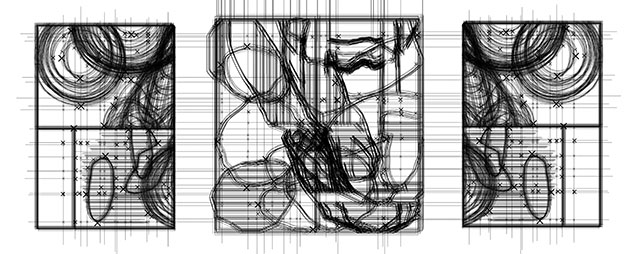

In this "warm-up" drawing exercise, students apply a range of techniques related to orthographic projection, and demonstrate a competency in the depiction of three-dimensional space and form through surface rendering in two dimensions.
After performing a set of solid-void experiments in casting plaster around elastic vessels, students document the results in elevation and section using the six-view orthographic drawing format. A digital model may be used for this purpose, but the majority of the final drawing is completed by hand using pencil on drafting vellum. Final drawings are presented as an overlay of three layers: with sectional drawings overlaid on top of elevations, both of which are produced in pencil on vellum, and are overlaid by an analytical layer which is produced as a digital print on transparent acetate.
Elevational Layer A six-view orthographic drawing of each elevation of the plaster model, including hidden lines for all relevant edges and hidden silhouette lines for curved surfaces. All visible surfaces are rendered using one or more of a set of surface rendering styles discussed in class.
Sectional Layer Six sections of the plaster model, each drawn in a parallel plane to each of the elevational views, and drawn as an overlay. The material which intersects the plane of the sectional cut is depicted as poche, using one of the styles described in class. Students flow elevation drawing protocols as described above for all elevational information.
Analytic Layer A digital print on transparent acetate overlaid upon the drawings listed above, that explains the process by which the surfaces of the physical plaster model were mapped into the digital model.
There's more!
Some other projects from this same class have been posted, as well as some interesting student work from this same year.